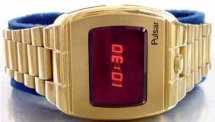Vintage Watch Site
An online resource for LED, LCD and digital watches
A History of Light Emitting Diode Displays
The LED was a team achievement. It was Richard S. Walton who patented the first LED timepiece in 1969, but credit must also go to the company RCA which developed a reliable electronic circuit, Litronics which developed a reliable LED display and there were also parallel projects. Also George Thiess and Willy Crabtree from Electro-Data based in Garland, Texas worked on a miniaturized LED watch circuitry which resulted in a short joint venture after being contacted by John M. Bergey an engineer at Hamilton Watch Company who lead a project team working on a digital wristwatch.
Bergey's team learned from Electro-Datas ideas and their combined patents finally made it possible to present a prototype in 1970 and a final marketable product named Pulsar was launched two years later on April 4th 1972 by the Hamilton Watch Company. Soon after Time Computer Inc. was established to market Pulsar LED watches. TC was a subsidiary of HMW Industries, a corporation formed after restructuring the Hamilton company. Due to enormous power consumption the LED display was turned off most of the time and only lit up to show time by means of pressing a (magnetic) button on the case.
The "P1" was offered for $2100 in a limited edition of 400 pieces in 18 kt. solid gold and sold out in a blitz by various celebrities around the world including the Shah of Iran. The price was outstanding and matched the price of an average car. Electro-Datas circuitry however proved to be a big failure and most of the first model watches had to be withdrawn from the market and fitted with a more robust Pulsar-made module 2800. This also ended the cooperation between both companies.

The value of the P1 still today sets at 10-15.000$ as only approx. 20 of the P1's exist today in working condition, thus making it the most desirable electronic watch ever made.
Note: Roger Riehl today is often credited for inventing the first LED watch (called Synchronar which was solar-charged. While there is no mistake that he greatly contributed to LED technology, he did not market it before 1974 and no proof can document his early achievements therefore he should not be credited with "inventing" the first LED. Still a damn cool watch though!